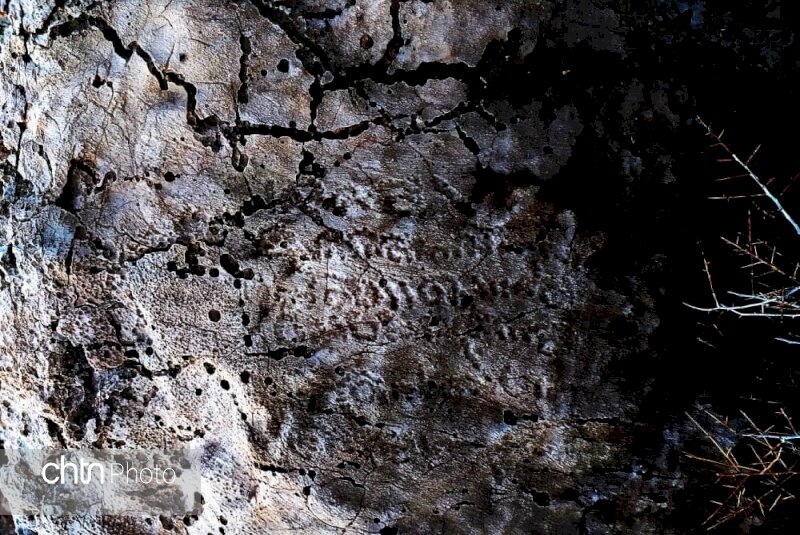Centuries-old inscription discovered near Istakhr ancient city

TEHRAN –A Sassanid-era (224–651) rock-carved inscription has recently been discovered near the ancient city of Istakhr, in Marvdasht plain, which is home to the UNESCO-registered sites of Persepolis and Pasargadae as well as tens of other magnificent structures, in southern Fars province.
The inscription bears Middle Persian (or Pahlavi) script in six lines, Said Hamid Fadai who presides over Persepolis World Heritage site.
Because of erosion of the inscription, specialized archaeologists and historians have read and translated it carefully, the official added.
The name of Zarathustra is engraved on this inscription that measures 40 by 35 centimeters, he noted.
The name Zarathustra has appeared in historical paper documents, but this is the first time it has been identified on an inscription, he explained.
Persian language, also called Farsi, is a member of the Iranian branch of the Indo-Iranian language family. Old Persian, spoken until approximately the 3rd century BC, is attested by numerous inscriptions written in cuneiform, most notable of which is the great monument of Darius I at Bisotun, western Iran. Middle Persian, spoken from the 3rd century BC to the 9th century CE, is represented by numerous epigraphic texts of Sasanian kings, written in Aramaic script; there is also varied literature in Middle Persian embracing both the Zoroastrian and the Manichaean religious traditions. Pahlavi was the name of the official Middle Persian language of the Sassanian empire, according to Britannica.
The ancient city of Istakhr was the seat of local governments and a royal residence of Persian kings during the Sassanid era. Moreover, it acquired importance as a center of priestly wisdom and orthodoxy.
Istakhr rose to fame when Ardashir I, the founder of the Sasanian Empire, chose it as his residence in 224 CE when the Persian nobleman dethroned a lawful ruler in Persia, Artabanus IV, king of the Parthian Empire.
The builders of Istakhr often reused architectural elements from the monuments of Persepolis. The Achaemenid royal tombs of Naqsh-e Rostam are not far from Istakhr too.
Istakhr remained popular after the fall of Sassanids by Arab innovators. According to the Oriental Institute of the University of Chicago, the geographer Istakhri wrote that in the tenth century, its houses were built of clay, stone, or gypsum according to the wealth of their owners.
Furthermore, Istakhr has yielded many magnificent relics so far. An ancient trash pit at Istakhr proved to be a very valuable source of finds. According to archaeological sources, the entire site is perforated by several sewage or storage wellholes. The holes are often “locked” by caps of brick or stone, and therefore an approximately contemporaneous mixture of broken and discarded pots, personal ornaments, stone and bronze objects, and a large number of coins was preserved in them.
Today, Istakhr is nothing but a plain full of shreds, scattered architectural remains, and a few ruins. The walled-in area measured 1,400 by 650 meters and was surrounded by a ditch that was connected to a nearby river.
The ancient region, known as Pars (Fars), or Persis, was the heart of the Achaemenid Empire founded by Cyrus the Great and had its capital at Pasargadae. Darius I the Great moved the capital to nearby Persepolis in the late 6th or early 5th century BC. Alexander the Great defeated the Achaemenian army at Arbela in 331 and burned Persepolis apparently as revenge to the Persians because it seems the Persian King Xerxes had burnt the Greek City of Athens around 150 years earlier.
Persis became part of the Seleucid kingdom in 312 after Alexander’s death. The Parthian empire (247 BC– 224 CE) of the Arsacids (corresponding roughly to the modern Khorasan in Iran) replaced the Seleucids' rule in Persis during 170–138 BC. The Sasanid Empire (224 CE–651) had its capital at Istkhr. Not until the 18th century, under the Zand dynasty (1750–79) of southern Iran, did Fars again become the heart of an empire, with its capital at Shiraz.
ABU/
